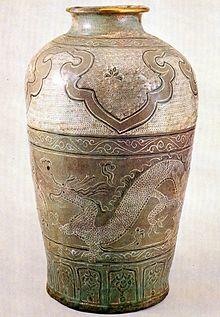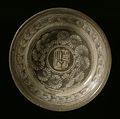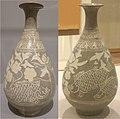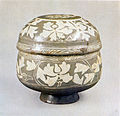| Buncheong | |
 Buncheong Ware with Inlaid Dragon and Stamped Design, Joseon Dynasty, National Treasure No. 259 | |
| Korean name | |
|---|---|
| Hangul | 분청사기 |
| Hanja | 粉靑沙器 |
| Revised Romanization | Buncheong Sagi |
| McCune–Reischauer | Punch'ǒng Sagi |
Buncheong ware, or Punch'ong, is a form of traditional Korean stoneware, with a bluish-green tone. Pots are coated with a white slip, and decorative designs are painted on using an iron pigment. The style of stoneware arose in the 14th century and continues today.
History
Buncheong ware developed from the earlier Goryeo celadon inlay technique called sanggam and rapidly distinguished itself.[1][2] The style emerged in the early Joseon dynasty, largely replacing the style of celadon in common use. In contrast to the refined elegance of Goryeo celadon, buncheong is designed to be natural, unassuming, and practical.[3] However, it all but disappeared from Korea after the 16th century due to the popularity of Joseon white porcelain.[4]
Through a series of cultural and economic circumstances, Buncheong wares in its heyday were exported to Japan by practitioners of the Japanese tea ceremony.[5] After they were adopted by the Japanese tea masters, they started to influence Japanese ceramics. And from Japan, Buncheong spread widely and became known as Mishima pottery.
In the 20th century, elements of Buncheong influenced many artists seeking insight into Asian ceramic traditions, and Buncheong continues to inspire artists to this day. Today, some Korean artists are working in stoneware with Buncheong techniques. The development of Buncheong is described in the 2011 book Korean Buncheong Ceramics from Leeum, Samsung Museum of Art, published to accompany the exhibition Poetry in Clay in New York and San Francisco.
The National Museum of Korea houses a large collection of Buncheong ware, as well as the Leeum, Samsung Museum of Art in Seoul.[6]
Characteristics
Buncheong is characterised by the use of a dark, iron bearing clay, white slip for decoration and a clear glaze. Decorations can be white slip brushed on, drawing through white slip to reveal the dark body, iron oxide pigments applied with a brush and other methods all employing white slip on the dark body.
Gallery
See also
References
- ^ Koehler, Robert (7 September 2015). Korean Ceramics: The Beauty of Natural Forms. Seoul Selection. ISBN 9781624120466. Retrieved 29 March 2017.
- ^ "punch'ong pottery | Korean art". Encyclopedia Britannica. Retrieved 30 March 2017.
- ^ Koehler, Robert (7 September 2015). Korean Ceramics: The Beauty of Natural Forms. Seoul Selection. ISBN 9781624120466. Retrieved 29 March 2017.
- ^ Lee, Author: Soyoung. "Joseon Buncheong Ware: Between Celadon and Porcelain". The Met’s Heilbrunn Timeline of Art History. Metropolitan Museum of Art. Retrieved 29 March 2017.
- ^ Knapp J. Buncheong Ceramics. Ceramics Monthly [serial on the Internet]. (2012, Jan), [cited December 2, 2015]; 60(1): 24-25. Available from: Academic Search Complete.
- ^ "Seoul's best museums". CNN Travel. Archived from the original on 2012-09-28. Retrieved 30 March 2017.
Further reading
- Soyoung Lee, Seung-chang Jeon. Korean Buncheong Ceramics from Leeum, Samsung Museum of Art. Metropolitan Museum of Art. 2011. ISBN 978-0300155167
- Masterpieces of Punchong (Buncheong, Punch'ong) Ware from the Ho-Am Art Museum. Ho-Am Art Museum. 1993
External links
![]() Media related to Buncheong ware at Wikimedia Commons
Media related to Buncheong ware at Wikimedia Commons



.jpg)
.jpg)

